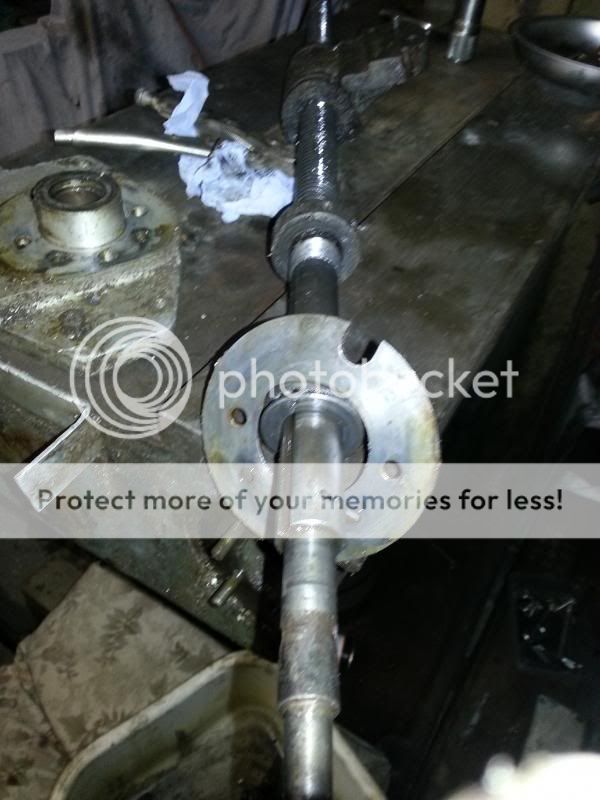Just catching up on what I have done so far
Got the mill close to its final resting place in the corner of my workshop.
Its underneath a pretty hefty RSJ that supports the mezzanine so I reckon that with a girder clamp fitted that should be good for lifting it off the pallet.
I also wanted to rig a smaller RSJ to use a girder trolley on to be able to easily lift engine blocks etc onto the table and also to help get the table itself in position.
The way they built the mezzanine they have fitted the rafters inside the main RSJ which is a real pain as it restricts the space, so I decided to go with a 100mm RSJ so it could clear the rafters and still fit in the web of the RSJ rather than suspend beneath.
Best laid plans and all that
, off I went to the local steel fabricator to see what he had lying around. Didn't have a long enough piece of 100mm UC but had 6m of 100mm channel for £60 which seemed reasonable so have used that and am going to bolt back to back to make up an H shape.
This is the span it will cover.
U channels bolted together and ends notched to allow it to sit on main RSJ's
Any thoughts on whether this will have materially weakened the end of the beam? I can bolt or weld a right angle to create a new plate that sits ontop of the beam if necessary….
All fitted in place….
The beauty of this approach is I can slide the cross member along the big RSJ meaning I can use it in different parts of the workshop
Ordered up a 2T beam clamp and 1T girder trolley from "Safety Lifting Gear" which arrived next day and seems to work pretty well.Next job is to start stripping down the mill
Cheers,
Paul.





![[IMG]](https://i1117.photobucket.com/albums/k599/mm289/Workshop/2013-09-22185437_zpsc3c8ba3b.jpg)
![[IMG]](https://i1117.photobucket.com/albums/k599/mm289/Workshop/2013-09-22185428_zps001e12e9.jpg)
![[IMG]](https://i1117.photobucket.com/albums/k599/mm289/Workshop/2013-09-22185424_zps8fccbd17.jpg)
![[IMG]](https://i1117.photobucket.com/albums/k599/mm289/Workshop/2013-09-22185414_zps2764e88c.jpg)
![[IMG]](https://i1117.photobucket.com/albums/k599/mm289/Workshop/2013-09-22185410_zpse3092371.jpg)

![[IMG]](https://i1117.photobucket.com/albums/k599/mm289/Workshop/2013-11-12182144_zpsc726f825.jpg)
 , off I went to the local steel fabricator to see what he had lying around. Didn't have a long enough piece of 100mm UC but had 6m of 100mm channel for £60 which seemed reasonable so have used that and am going to bolt back to back to make up an H shape.
, off I went to the local steel fabricator to see what he had lying around. Didn't have a long enough piece of 100mm UC but had 6m of 100mm channel for £60 which seemed reasonable so have used that and am going to bolt back to back to make up an H shape.![[IMG]](https://i1117.photobucket.com/albums/k599/mm289/Workshop/2013-11-12182242_zpsb12612e3.jpg)
![[IMG]](https://i1117.photobucket.com/albums/k599/mm289/Workshop/2013-11-12182218_zps93bef742.jpg)
![[IMG]](https://i1117.photobucket.com/albums/k599/mm289/Workshop/2013-11-12185738_zps643648d5.jpg)
![[IMG]](https://i1117.photobucket.com/albums/k599/mm289/Workshop/2013-11-12190416_zps9e32d1f2.jpg)

![[IMG]](https://i1117.photobucket.com/albums/k599/mm289/Workshop/2013-08-30191005_zps3871f412.jpg)
![[IMG]](https://i1117.photobucket.com/albums/k599/mm289/Workshop/2013-09-22185320_zpsc76d0806.jpg)
![[IMG]](https://i1117.photobucket.com/albums/k599/mm289/Workshop/2013-11-17170955_zps42dec284.jpg)
![[IMG]](https://i1117.photobucket.com/albums/k599/mm289/Workshop/2013-09-22190203_zps62ac0fed.jpg)
![[IMG]](https://i1117.photobucket.com/albums/k599/mm289/Workshop/2013-09-22185910_zpsbff1b1f4.jpg)

![[IMG]](https://i1117.photobucket.com/albums/k599/mm289/Workshop/2013-09-22185501_zpsc7d2ea4a.jpg)
![[IMG]](https://i1117.photobucket.com/albums/k599/mm289/Workshop/2013-09-22185246_zpsf28d551e.jpg)
![[IMG]](https://i1117.photobucket.com/albums/k599/mm289/Workshop/2013-11-17171810_zpsc7933d76.jpg)
![[IMG]](https://i1117.photobucket.com/albums/k599/mm289/Workshop/2013-11-17171119_zps37e14554.jpg)
![[IMG]](https://i1117.photobucket.com/albums/k599/mm289/Workshop/2013-11-17171056_zps0284908f.jpg)
![[IMG]](https://i1117.photobucket.com/albums/k599/mm289/Workshop/2013-11-21215844_zpsb6f80521.jpg)
![[IMG]](https://i1117.photobucket.com/albums/k599/mm289/Workshop/2013-11-21214325_zps7265636c.jpg)
![[IMG]](https://i1117.photobucket.com/albums/k599/mm289/Workshop/2013-11-17175428_zpsee0d8315.jpg)
![[IMG]](https://i1117.photobucket.com/albums/k599/mm289/Workshop/2013-11-21212326_zps26706408.jpg)
![[IMG]](https://i1117.photobucket.com/albums/k599/mm289/Workshop/2013-11-21212331_zps53cc1e71.jpg)
![[IMG]](https://i1117.photobucket.com/albums/k599/mm289/Workshop/2013-11-21213752_zps421257d4.jpg)
![[IMG]](https://i1117.photobucket.com/albums/k599/mm289/Workshop/2013-11-21213752v2_zps36da9f41.jpg)
![[IMG]](https://i1117.photobucket.com/albums/k599/mm289/Workshop/2013-11-23133528_zps4d6fe995.jpg)
![[IMG]](https://i1117.photobucket.com/albums/k599/mm289/Workshop/2013-12-01160446_zps4ac76563.jpg)
![[IMG]](https://i1117.photobucket.com/albums/k599/mm289/Workshop/2013-12-01172731_zps089f5a44.jpg)
![[IMG]](https://i1117.photobucket.com/albums/k599/mm289/Workshop/2013-12-01172628_zps695104f7.jpg)
![[IMG]](https://i1117.photobucket.com/albums/k599/mm289/Workshop/2013-12-01172643_zps09396043.jpg)
![[IMG]](https://i1117.photobucket.com/albums/k599/mm289/Workshop/2013-12-01173146_zps979484d8.jpg)
![[IMG]](https://i1117.photobucket.com/albums/k599/mm289/Workshop/2013-12-01173353_zpscd2da7a2.jpg)
![[IMG]](https://i1117.photobucket.com/albums/k599/mm289/Workshop/2013-12-01173409_zpse1b3227b.jpg)
![[IMG]](https://i1117.photobucket.com/albums/k599/mm289/Workshop/2013-12-01173629_zpsec905330.jpg)
![[IMG]](https://i1117.photobucket.com/albums/k599/mm289/Workshop/2013-12-01174008_zpsd2ce1551.jpg)
![[IMG]](https://i1117.photobucket.com/albums/k599/mm289/Workshop/2013-12-01174643_zps08377ded.jpg)
![[IMG]](https://i1117.photobucket.com/albums/k599/mm289/Workshop/2013-12-01175011_zps6d075b4d.jpg)
![[IMG]](https://i1117.photobucket.com/albums/k599/mm289/Workshop/2013-12-01175034_zpse4dee7ad.jpg)
![[IMG]](https://i1117.photobucket.com/albums/k599/mm289/Workshop/2013-12-01175045_zpsb42223f2.jpg)
![[IMG]](https://i1117.photobucket.com/albums/k599/mm289/Workshop/2013-12-01175206_zps76437a6b.jpg)
![[IMG]](https://i1117.photobucket.com/albums/k599/mm289/Workshop/2013-12-01180359_zpsec401e1e.jpg)
![[IMG]](https://i1117.photobucket.com/albums/k599/mm289/Workshop/2013-12-01180404_zps8a013ed1.jpg)
![[IMG]](https://i1117.photobucket.com/albums/k599/mm289/Workshop/2013-12-01180440_zps49ad792a.jpg)
![[IMG]](https://i1117.photobucket.com/albums/k599/mm289/Workshop/2013-12-01180654_zps62a541a0.jpg)

![[IMG]](https://i1117.photobucket.com/albums/k599/mm289/Workshop/2013-12-27172913_zps954157e7.jpg)
![[IMG]](https://i1117.photobucket.com/albums/k599/mm289/Workshop/2013-12-27174528_zps3f56f22a.jpg)
![[IMG]](https://i1117.photobucket.com/albums/k599/mm289/Workshop/2013-12-27181019_zps8abefb7a.jpg)
![[IMG]](https://i1117.photobucket.com/albums/k599/mm289/Workshop/2013-12-27183147_zps3ab27524.jpg)
![[IMG]](https://i1117.photobucket.com/albums/k599/mm289/Workshop/2013-12-27183212_zpsab354bba.jpg)
![[IMG]](https://i1117.photobucket.com/albums/k599/mm289/Workshop/2013-12-27183235_zps15daea20.jpg)
![[IMG]](https://i1117.photobucket.com/albums/k599/mm289/Workshop/2013-12-27184739_zpsbb0d398a.jpg)
![[IMG]](https://i1117.photobucket.com/albums/k599/mm289/Workshop/2013-12-27184801_zpsbe4fdc06.jpg)


